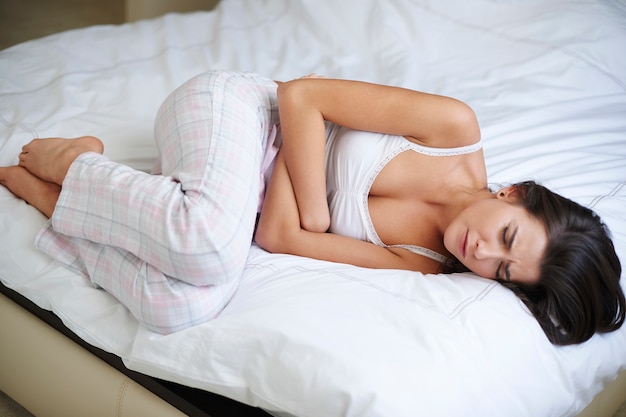
Many women experience pelvic pain or cramping during the month, and while this is often tied to menstruation, it’s not always the case. Cramping without a period could be caused by several factors, ranging from mild issues to more serious medical conditions such as pregnancy, cysts, or even cancer. Here’s a breakdown of potential reasons for cramping without a menstrual cycle:
### Possible Causes of Cramps Without Periods
**1. Inflammatory Bowel Disease (IBD)**:
Conditions like Crohn’s Disease or Ulcerative Colitis cause chronic inflammation in the digestive tract, leading to cramping. Depending on the type, pain may vary in intensity and location. Other symptoms include changes in bowel habits, blood in stool, fatigue, and weight loss.
**2. Ovulation**:
Around 10–14 days before a period, ovaries release an egg, which can cause a temporary sharp or dull pain called mittelschmerz on one side of the lower abdomen.
**3. Ruptured Ovarian Cyst**:
Generally harmless, ovarian cysts can burst and cause sudden, intense cramps in the lower abdomen, sometimes accompanied by spotting.
**4. Pregnancy**:
In early pregnancy, implantation can cause mild cramping, often before a woman even realizes she’s pregnant. Symptoms such as nausea typically appear a few weeks later.
**5. Ectopic Pregnancy**:
This occurs when a fertilized egg grows outside the uterus, often in a fallopian tube. It causes sharp, localized pain and can be life-threatening without prompt treatment.
**6. Miscarriage**:
Cramping early in pregnancy may indicate a miscarriage, especially if accompanied by bleeding. However, it doesn’t always result in pregnancy loss.
**7. Endometriosis**:
This chronic condition happens when tissue similar to uterine lining grows outside the uterus. It can cause persistent pain, discomfort during intercourse, and even infertility.
**8. Pelvic Inflammatory Disease (PID)**:
A bacterial infection of the reproductive organs, often resulting from untreated sexually transmitted infections (STIs). Symptoms include cramping, abnormal discharge, fever, and painful urination.
**9. Pelvic Floor Dysfunction**:
Cramping due to muscle spasms in the pelvic area often occurs after trauma, such as childbirth or an injury, and can affect the lower belly, back, and groin.
**10. Interstitial Cystitis**:
Known as painful bladder syndrome, it can cause cramps, pelvic pain, and frequent urination. Discomfort usually worsens as the bladder fills.
**11. Irritable Bowel Syndrome (IBS)**:
IBS can lead to belly cramping, bloating, or alternating diarrhea and constipation. Symptoms often intensify during menstruation.
**12. Appendicitis**:
If the appendix becomes inflamed, cramping may start around the belly button and move to the lower right abdomen. It’s a medical emergency when accompanied by fever, nausea, or vomiting.
**13. Ovarian Cancer**:
Early ovarian cancer symptoms often include vague, persistent cramps or abdominal pressure. Additional signs can be bloating and feeling full quickly.
**14. Perimenopause**:
In the years leading up to menopause, irregular periods and cramping may still occur even when a period doesn’t arrive.
**15. Uterine Cervix Stenosis**:
Scarring or narrowing of the cervix from surgery or trauma can lead to painful cramping without bleeding.
**16. Autoimmune Oophoritis**:
A rare condition where the immune system attacks the ovaries, leading to cramping, hormonal irregularities, and infertility.
**17. Delayed Periods**:
Cramping may occur when ovulation or menstruation is delayed, often accompanied by period-like symptoms.
**18. Menopause**:
As menstruation ceases with age, some women experience lingering cramps due to hormonal changes.
**19. Eating Disorders**:
Conditions like bulimia and anorexia can disrupt menstrual cycles and cause cramping due to hormonal imbalances.
**20. Anovulation**:
When ovulation doesn’t occur, hormonal shifts can mimic premenstrual symptoms, including cramping.
**21. Thyroid Disorders**:
Thyroid issues disrupt hormone levels, affecting the menstrual cycle and potentially causing cramping without a period.
**22. Hormonal Birth Control**:
Certain contraceptives can prevent menstruation but still cause mild cramping or spotting.
**23. Stress**:
High cortisol levels from stress can interfere with hormones that regulate the menstrual cycle, resulting in cramping without a period.
**24. Polycystic Ovary Syndrome (PCOS)**:
A hormonal disorder causing irregular cycles, ovarian cysts, and cramping. It’s often linked to weight gain and insulin resistance.
**25. Uterine Polyps**:
Noncancerous growths in the uterine lining can lead to cramping and fertility issues.
**26. STIs and UTIs**:
Conditions like chlamydia, gonorrhea, or urinary tract infections can cause pelvic pain and cramping.
**27. Kidney Stones**:
Pain from stones moving through the urinary tract can mimic menstrual cramps.
**28. Fibroids or Tumors**:
Noncancerous uterine growths may trigger cramping and pelvic pain.
**29. Ovarian Torsion**:
A twisting of the ovary or fallopian tube interrupts blood flow, causing sudden, severe cramping.
**30. Other Infections**:
Infections of the pelvic or abdominal area, like diverticulitis or Skene’s glands issues, may lead to cramps.
**31. Gas and Bloating**:
Digestive discomfort from gas or bloating can mimic menstrual cramps, often caused by certain foods or food intolerances.
**32. Stomach Flu or Food Poisoning**:
Viral or bacterial infections from contaminated food often cause cramps, nausea, and diarrhea.
**33. Abdominal Surgery**:
Scar tissue after surgery can cause cramping or adhesions that limit organ function.
### Treatment and Relief
For mild cramping, remedies like heat packs, warm baths, or hot drinks can help. Gentle physical activity, such as walking, may also provide relief. Maintaining a balanced diet, staying hydrated, and reducing stress through activities like yoga or meditation can help prevent recurring cramps.
If cramping is severe, persistent, or accompanied by unusual symptoms like fever, vomiting, or heavy bleeding, it’s essential to consult a doctor for proper diagnosis and treatment. Many conditions causing cramps require medical intervention, and ignoring the symptoms could worsen the situation. Always rely on a healthcare provider for accurate guidance and avoid self-medication.